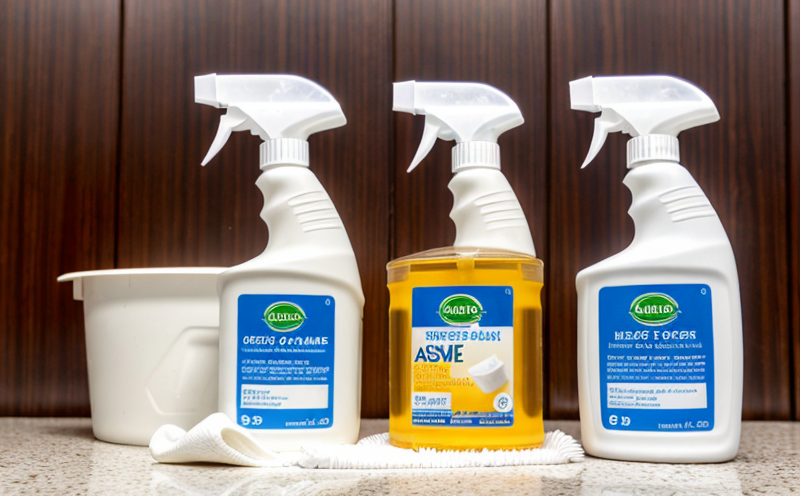EN 1276 Bactericidal Activity Testing of Disinfectants
The EN 1276 standard specifies methods for determining the bactericidal activity of disinfectants against L. innocua. This testing is crucial in ensuring that cleaning and hygiene products effectively reduce bacterial contamination, thereby enhancing public health and safety.
Before diving into the specifics, let's consider why this test is important in the broader context of chemical testing for cleaning and hygiene products. In many countries, regulations mandate that disinfectants be proven effective against specific pathogens to ensure they can safely and effectively combat infections. EN 1276 provides a standardized approach to evaluate these properties.
EN 1276 is relevant in various sectors including healthcare, hospitality, food processing, and public spaces where hygiene and sanitation are paramount. Compliance with this standard not only ensures that products meet regulatory requirements but also enhances consumer trust and brand reputation.
The testing method involves exposing bacterial cultures to the disinfectant under controlled conditions. The efficacy is then assessed by measuring the reduction in bacterial population. This section will delve into the detailed process, including specimen preparation, test procedures, and reporting of results.
Specimen preparation for this test typically involves culturing Lactobacillus innocua, a bacterium that mimics Gram-positive cocci in its behavior but is harmless to humans. The bacteria are inoculated onto agar plates and incubated until they reach a logarithmic growth phase, which ensures consistent starting conditions.
The disinfectant solution is then applied at the specified concentration and contact time, typically 30 minutes as per standard protocols. Following this exposure period, the treated samples are plated to assess bacterial survival rates. The control plates receive no treatment and serve as a baseline for comparison.
Quantitative analysis of bacterial colonies on both treated and untreated plates is conducted using standardized counting methods. This process yields data that can be used to calculate the reduction in bacterial population, which directly indicates the disinfectant's efficacy.
The results are reported according to EN 1276 criteria, detailing the concentration tested, contact time, and percentage of bacterial kill achieved. Compliance with this standard ensures that products meet legal and regulatory requirements, but it also provides valuable data for quality assurance and continuous improvement in product development.
Understanding these steps is crucial for any organization involved in the production or use of disinfectants. It allows them to ensure their products are safe and effective, thereby contributing positively to public health initiatives.
Applied Standards
The EN 1276 standard has been widely adopted across Europe for its rigorous testing protocols. The standard is based on ISO standards but specifically tailored for the European market. It ensures that disinfectants are tested under conditions that reflect real-world usage, making it a reliable benchmark.
EN 1276 specifies several key parameters including the concentration of the disinfectant, contact time, and the type of bacteria used in the test. These parameters are chosen to simulate typical use cases in various hygiene settings such as hospitals, schools, and food establishments.
The standard also includes detailed instructions on how to prepare specimens and conduct tests to ensure consistency across different laboratories. This uniformity is essential for accurate results and reliable comparison between different products.
Compliance with EN 1276 not only ensures regulatory compliance but also enhances brand reputation by demonstrating a commitment to high-quality, effective disinfectants. It provides consumers with confidence in the efficacy of the product, which can be crucial in maintaining trust and loyalty.
Benefits
Compliance with EN 1276 brings several significant benefits for manufacturers, distributors, and end-users of disinfectants. Firstly, it ensures that products meet stringent regulatory requirements, thereby facilitating market access to countries that have adopted this standard.
The standardized testing process provided by EN 1276 allows for consistent evaluation of product efficacy across different laboratories. This consistency is crucial for maintaining the reliability and reputation of brands in a competitive market. It also helps manufacturers identify areas for improvement and optimize their products for better performance.
For end-users, particularly those in high-risk environments such as healthcare facilities or food processing plants, compliance with EN 1276 means they can rely on disinfectants that have been rigorously tested to ensure they are effective against a wide range of pathogens. This reliability is vital for maintaining safe and hygienic conditions.
The standard also plays a role in public health initiatives by supporting the development of effective disinfectants. By ensuring products meet these high standards, it contributes to the overall improvement of hygiene practices and infection control measures.
Customer Impact and Satisfaction
Customers, especially those in regulated industries such as healthcare and food processing, greatly benefit from products that comply with EN 1276. Compliance ensures that disinfectants are effective against a range of pathogens, which is critical for maintaining hygiene standards.
The standard's rigorous testing procedures provide customers with confidence in the quality and efficacy of the products they purchase. This confidence translates into higher customer satisfaction and loyalty. For healthcare facilities, for instance, this means peace of mind knowing that their disinfectants are effective against pathogens, which can prevent outbreaks and infections.
Additionally, compliance with EN 1276 can enhance a company's reputation in the market. It signals to customers that the company prioritizes quality and safety, which is particularly important for brands aiming to establish themselves as leaders in hygiene and sanitation products.





